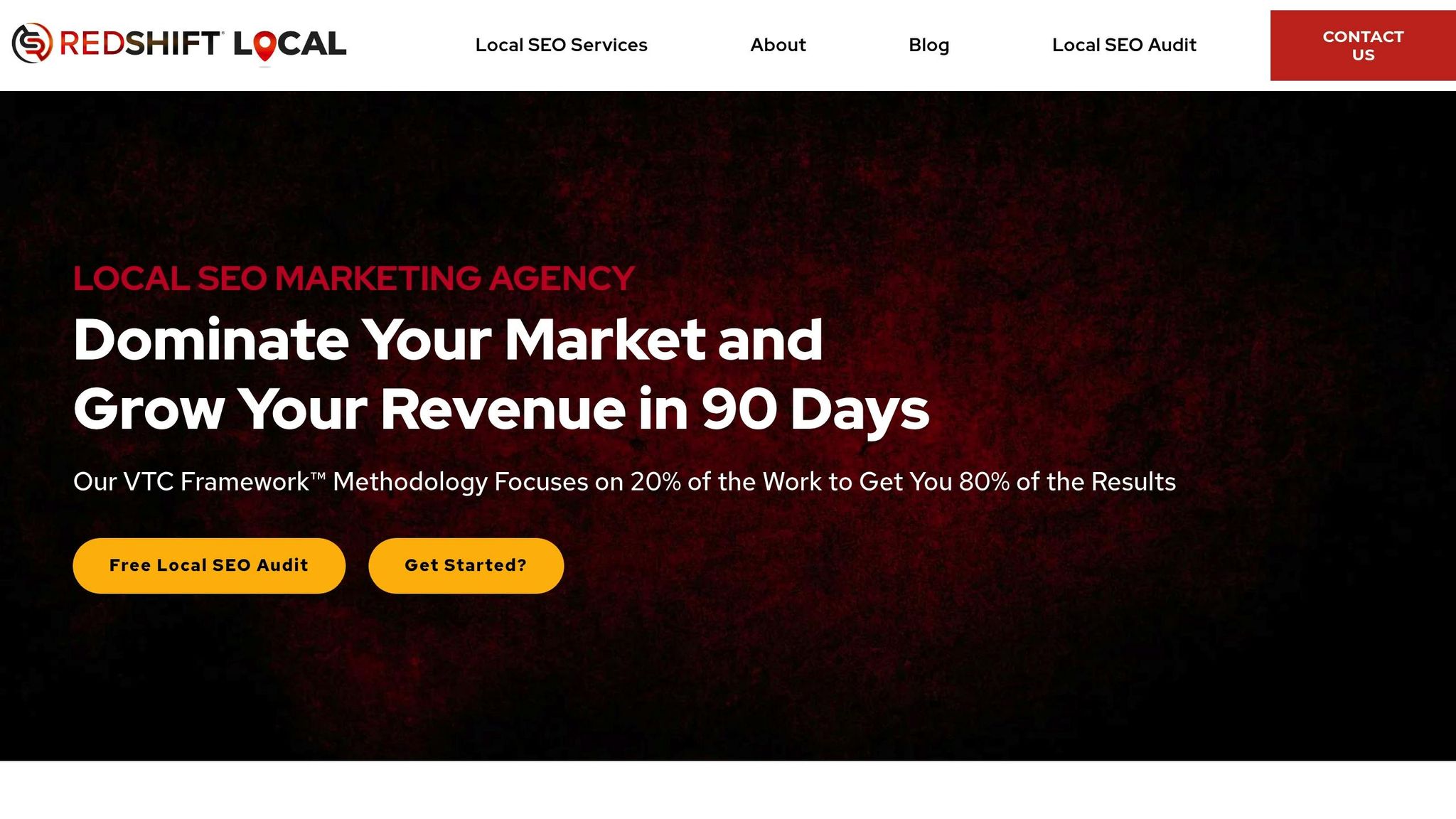Mobile speed can make or break your local search rankings. Why? Because Google prioritizes fast-loading mobile pages to provide users with quick, seamless results – especially for high-intent "near me" searches like "coffee shop near me" or "emergency plumber." A slow mobile site frustrates users, increases bounce rates, and sends negative signals to Google, which can push your business lower in search results.
Here’s what you need to know:
- Google uses mobile-first indexing: Your mobile site’s performance directly affects rankings, even if your desktop site is fast.
- Slow sites lose customers: Users often leave within seconds if a page loads slowly, costing you leads and revenue.
- Core Web Vitals matter: Metrics like loading speed, interactivity, and visual stability are key ranking factors.
- Faster sites win local map pack spots: Businesses with quicker mobile pages often outrank competitors, even if they’re farther away.
Optimizing mobile speed isn’t complicated. Compress images, clean up code, use faster formats like WebP, and leverage tools like Google PageSpeed Insights to track performance. By addressing mobile speed issues, you’ll improve rankings, reduce bounce rates, and attract more local customers.
Mobile Page Speed: Boost Local SEO & Google Ranking
How Mobile Speed Affects Local SEO Performance
Mobile speed is a game-changer for local SEO. With Google now factoring mobile performance into its ranking algorithms, a site’s technical efficiency on mobile devices works hand-in-hand with traditional elements like reviews and citations. As the focus shifts to mobile-first, here’s how mobile speed influences local SEO.
Google’s Mobile-First Indexing Priority
Google’s mobile-first indexing means it primarily evaluates the mobile version of a website when determining rankings. This makes mobile page speed a critical factor for local search visibility. Metrics like Core Web Vitals – covering loading speed, interactivity, and visual stability – are key benchmarks Google uses. Websites that deliver a seamless mobile experience are more likely to rank higher. In competitive local markets, even small speed improvements can give a business the edge over rivals with similar ratings and location relevance.
The Impact of Slow Mobile Sites on Rankings
A slow-loading mobile site can seriously hurt your local search performance. When visitors experience delays, they often leave the site quickly, signaling to Google that the page isn’t meeting user expectations. This behavior, combined with poor Core Web Vital scores like slow Largest Contentful Paint (LCP) or high First Input Delay (FID), can push your site further down the rankings. Worse yet, it might even cost you a spot in the coveted local map pack. For local businesses, optimizing mobile performance isn’t optional – it’s essential.
Why Mobile Speed Matters for ‘Near Me’ Searches
"Near me" searches are often made by users looking for immediate solutions – whether it’s finding the nearest coffee shop or an urgent care center. In these moments, speed is everything. A fast-loading mobile site not only improves user satisfaction but also increases the likelihood of appearing in local map packs. In fact, Google’s emphasis on user experience means a business with a faster site might outrank a closer competitor with a slower one. For businesses, ensuring a quick and smooth mobile experience can make all the difference in capturing these high-intent searches.
Problems Local Businesses Face with Slow Mobile Sites
When it comes to local businesses, a slow mobile site can feel like a hidden anchor dragging everything down. It impacts customer acquisition, search rankings, and even the ability to compete effectively in local markets. The ripple effect is significant, touching lead generation, visibility, and overall business performance.
Lost Customers from High Bounce Rates
Mobile users don’t wait. A few extra seconds of loading time can be all it takes to lose a potential customer. Imagine someone searching for "plumber near me" while dealing with a burst pipe – they’re not sticking around for a slow site to load. They’ll move on to a competitor whose site loads instantly.
High bounce rates caused by sluggish mobile performance mean fewer leads. Users who leave before the site fully loads never get to see the business’s contact details, services, or any compelling reason to stick around. This is especially tough for local businesses like restaurants, home repair services, or medical practices, where quick decisions often translate directly into revenue.
Timing makes this issue worse. Local businesses tend to get the most mobile traffic during peak hours like lunch breaks, evenings, and weekends. These are the times when potential customers are ready to make snap decisions about where to eat, whom to call, or where to go. If a site lags, engagement drops, and businesses lose out on these high-value moments. Worse yet, this lack of engagement sends negative signals to search engines, further hurting visibility.
Lower Rankings in Local Search Results
A slow mobile site doesn’t just frustrate users – it also damages search rankings. High bounce rates and poor engagement metrics tell Google that the site isn’t meeting user expectations. For local businesses, this can create a downward spiral where poor performance leads to lower rankings, making it even harder to attract new customers.
The local map pack is where this impact is most obvious. Only three businesses make it into this coveted space at the top of local search results. Even a restaurant with glowing reviews and a perfect location can lose its spot in the map pack to a competitor with a faster-loading site. And since most users rarely scroll past the first few results, falling out of the map pack can mean a dramatic drop in visibility.
For businesses relying on high-intent "near me" searches, a slow site can be devastating. These searches often lead to immediate actions like phone calls, walk-ins, or bookings. A delay in loading means missed opportunities – and missed revenue.
Poor Customer Experience
Search rankings and bounce rates aside, slow mobile sites deal a heavy blow to customer experience. When someone is trying to check a restaurant’s menu, find a business’s hours, or access contact details, a slow site doesn’t just frustrate – it leaves a bad impression.
Trust takes a hit. People often associate slow or clunky websites with outdated or unprofessional businesses. For industries where trust is critical, like law firms or medical practices, this can be a dealbreaker. A slow-loading site might make potential clients question the business’s credibility before they even reach out.
On top of that, slow sites make basic tasks harder. Filling out a contact form, booking a reservation, or even pulling up directions becomes a chore. Many users will simply give up and turn to a competitor with a smoother, faster mobile experience – even if that competitor is farther away or charges a bit more. For local businesses, these lost opportunities can add up quickly.
Solutions to Improve Mobile Speed for Local SEO
Mobile speed issues don’t have to be deal-breakers for your local SEO efforts. With a few effective strategies, you can enhance your site’s performance and improve your search rankings without needing a complete website overhaul. These solutions tackle common problems like slow load times and high bounce rates head-on.
Optimize Images and Use Modern Formats
Images are often the culprits behind sluggish mobile site speeds. A large, unoptimized image can drag down loading times, which is a problem for local businesses that rely on visuals to attract customers.
To address this, compress image files using tools like TinyPNG or ImageOptim. Switch to modern formats like WebP or HEIF, which load faster while preserving image quality. Implement lazy loading as well – this ensures images are only loaded when users scroll to them, keeping the initial load time quick. These small adjustments can make a noticeable difference in performance.
Speed Up Pages Through Code Optimization
Bloated code can significantly slow down your site. Start by minifying your CSS and JavaScript files. This process strips out unnecessary spaces, comments, and characters, reducing file sizes without affecting functionality.
Enable browser caching so returning visitors can load stored files locally, speeding up repeat visits. Defer non-essential JavaScript (like scripts for contact forms or booking widgets) so the critical content – such as your business hours or contact details – appears immediately.
Using a Content Delivery Network (CDN) is another game-changer. CDNs store copies of your website’s files on servers in different locations, allowing users to load site assets from a server closer to them. This reduces load times and improves the overall browsing experience.
Create a Mobile-Friendly Design
Good design is just as important as technical fixes when it comes to mobile performance. Responsive design ensures your site adapts to different screen sizes, but true mobile optimization goes further. The goal is to create a seamless, user-friendly experience.
For starters, make navigation touch-friendly. Buttons and links should be large enough for easy tapping, and contact details like your phone number or address should be front and center. A cluttered interface can frustrate users, driving them away.
Stick to simplified layouts that prioritize essential information. Keep navigation intuitive and focus on displaying key details at the top, with more in-depth content further down the page.
You can also consider Accelerated Mobile Pages (AMP) to deliver lightweight, fast-loading versions of content like blog posts or service descriptions. While AMP has its limitations, it can significantly boost load times for mobile users.
Use Tools to Track and Improve Performance
Performance tracking tools are invaluable for identifying and fixing mobile speed issues. Platforms like Google PageSpeed Insights, Lighthouse, GTmetrix, and Pingdom provide detailed reports on your site’s performance. They highlight areas for improvement, such as uncompressed images, inefficient code, or slow-loading elements.
Google Lighthouse, in particular, is useful for simulating slower network conditions and evaluating Core Web Vitals – key performance metrics that affect search rankings.
sbb-itb-4b390eb
How RedShift Local Improves Mobile Speed for Local Businesses

RedShift Local takes a smart, focused approach to improving mobile speed for local businesses. Using their Digital Marketing Essentialism (DME) methodology, they zero in on the most impactful changes – those select 20% of fixes that yield 80% of the results. This approach ensures businesses see real, measurable performance gains without unnecessary complexity.
By combining proven mobile speed techniques with targeted audits and technical strategies, RedShift Local delivers results that matter.
Mobile Speed Audits and Local SEO Strategies
Every project begins with a Mobile Speed Audit tailored specifically for local businesses. These audits dig into key speed-related issues, uncovering areas that need attention. The result? A customized action plan that aligns with each business’s unique goals and challenges.
Technical SEO and Performance Monitoring
Once the audit is complete, RedShift Local focuses on refining the technical side of things. Their Website Optimization & Technical SEO services are designed to enhance both mobile responsiveness and speed. But they don’t stop there – they also implement ongoing performance monitoring to ensure these improvements stick over time.
Driving Business Growth Through Speed Optimization
Faster mobile speeds don’t just improve user experience – they help businesses grow. RedShift Local’s performance tracking tools make it easy to see the connection between speed optimizations and measurable outcomes like better customer engagement and improved local search rankings. When combined with Google Business Profile enhancements and locally targeted content, these strategies boost online visibility and help attract more customers.
Conclusion: The Return on Investment of Mobile Speed
Focusing on mobile speed optimization offers clear benefits for local businesses, directly impacting search rankings, customer engagement, and conversion rates. Prioritizing mobile performance often translates to tangible results, like higher visibility in search engines, better user interaction, and, ultimately, more sales.
Websites that load quickly keep users engaged, reduce bounce rates, and send positive signals to Google about the quality of the user experience. This enhanced performance can improve rankings for high-intent "near me" searches, which are critical for driving local foot traffic and phone inquiries.
On the flip side, ignoring mobile speed comes with real costs. Slow-loading pages frustrate users, lead to lost customers, and hurt rankings. In today’s fast-paced digital world, even a few seconds of delay can turn potential sales into missed opportunities.
Improving mobile speed isn’t about overhauling everything – it’s about making targeted changes that deliver the biggest gains. RedShift Local’s Digital Marketing Essentialism approach zeroes in on these key areas, ensuring businesses achieve meaningful results without unnecessary complexity.
For businesses looking to strengthen their online presence, investing in mobile speed optimization is one of the smartest moves they can make. The combined benefits of a smoother user experience, better search visibility, and happier customers create a ripple effect that fuels long-term growth. This kind of strategic focus not only enhances performance but also aligns with broader business goals.
When mobile speed, local SEO, and customer experience work together, the results speak for themselves: higher visibility, more customers, and increased revenue. By embracing these targeted improvements, local businesses can set the stage for sustained success in search rankings and customer satisfaction.
FAQs
How does mobile page speed affect my business’s ranking in local search results?
Why Mobile Page Speed Matters for Local Search
Mobile page speed is a key factor in how your business ranks in local search results, including the all-important local map pack. Google gives preference to websites that load quickly and work seamlessly on mobile devices because they offer a smoother user experience. On the flip side, a slow-loading site can drive users away, increasing bounce rates and hurting your search visibility.
With Google’s mobile-first indexing, the mobile version of your site takes center stage in determining your ranking. In simple terms, if your mobile site is slow, your overall performance in local search results will likely suffer. By speeding up your site, you not only improve the browsing experience for users but also boost your chances of ranking higher in local searches.
What common mistakes slow down mobile websites, and how can I fix them?
Common Mistakes That Slow Down Mobile Websites
A sluggish mobile website can frustrate users and hurt your local search rankings. Some of the biggest culprits include large, unoptimized images, excessive HTTP requests, underperforming hosting, missing caching mechanisms, oversized media files, and auto-playing videos. These issues can bog down load times, leaving visitors impatient and less likely to stick around.
So, how can you tackle these problems? Start by compressing and resizing your images to a more manageable size. Cut back on JavaScript and limit the number of HTTP requests. Adding caching can make repeat visits faster, while lazy loading ensures media files only load when they’re needed. By addressing these areas, you’ll not only speed up your site but also create a better experience for your users and improve your local search performance.
How can I measure and track my site’s mobile speed to improve local search rankings?
To keep tabs on your site’s mobile speed and performance, tools like Google PageSpeed Insights, GTmetrix, and Pingdom are incredibly helpful. These platforms offer detailed metrics, performance scores, and insights into Core Web Vitals, making it easier to pinpoint and fix speed-related problems.
By testing your site regularly with these tools, you can track improvements over time and ensure your mobile speed remains optimized. Maintaining fast mobile performance is key to boosting local search rankings and providing users with a seamless browsing experience.


